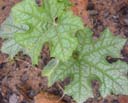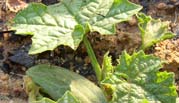 |
 |
 |
 |
Bitter Melon
Bitter melon grows in tropical areas, including parts of the Amazon, east Africa, Asia, and the Caribbean, and is cultivated throughout South America as a food and medicine. It's a slender, climbing annual vine with long-stalked leaves and yellow, solitary male and female flowers borne in the leaf axils. The fruit appears as a warty gourd, usually oblong and resembling a small cucumber. The young fruit is emerald green, turning to orange-yellow when ripe. At maturity the fruit splits into three irregular valves that curl backwards and release numerous brown or white seeds encased in scarlet arils. The Latin name Memorial means “to bite” (referring to the jagged edges of the leaf, which appear as if they have been bitten). All parts of the plant, including the fruit, taste bitter.
local people and indigenous tribes grow bitter melon in their gardens for food and medicine. They add the fruit and/or leaves to beans and soup for a bitter or sour flavor; parboiling it first with a dash of salt may remove some of the bitter taste. Medicinally, the plant has a long history of use by the indigenous peoples of the Amazon. A leaf tea is employed for diabetes; as a carminative for colic; topically for sores, wounds, and infections; internally and externally for worms and parasites; as an empennage; and as an antiviral for measles, hepatitis, and feverish conditions.
Bitter melon contains an array of novel and biologically active photochemical including triterpenes, proteins and steroids. In numerous studies, at least three different groups of constituents found in all parts of bitter melon have clinically demonstrated hypoglycemic properties (blood sugar lowering) or other actions of potential benefit against diabetes mellitus. These hypoglycemic chemicals include a mixture of steroidal saponins known as characins, insulin-like peptides, and alkaloids. The hypoglycemic effect is more pronounced in the fruit of bitter melon where these chemicals are in greater abundance. To date, close to 100 in vivo studies have demonstrated the blood glucose-lowering effect of this bitter fruit. The fruit has also shown the ability to enhance cells’ uptake of glucose, to promote insulin release, and potentiate the effect of insulin. In other in vivo studies, bitter melon fruit and/or seed has been shown to reduce total cholesterol and triglycerides in both the presence and absence of dietary cholesterol. In one study, elevated cholesterol and triglyceride levels in diabetic rats were returned to normal after 10 weeks of treatment.